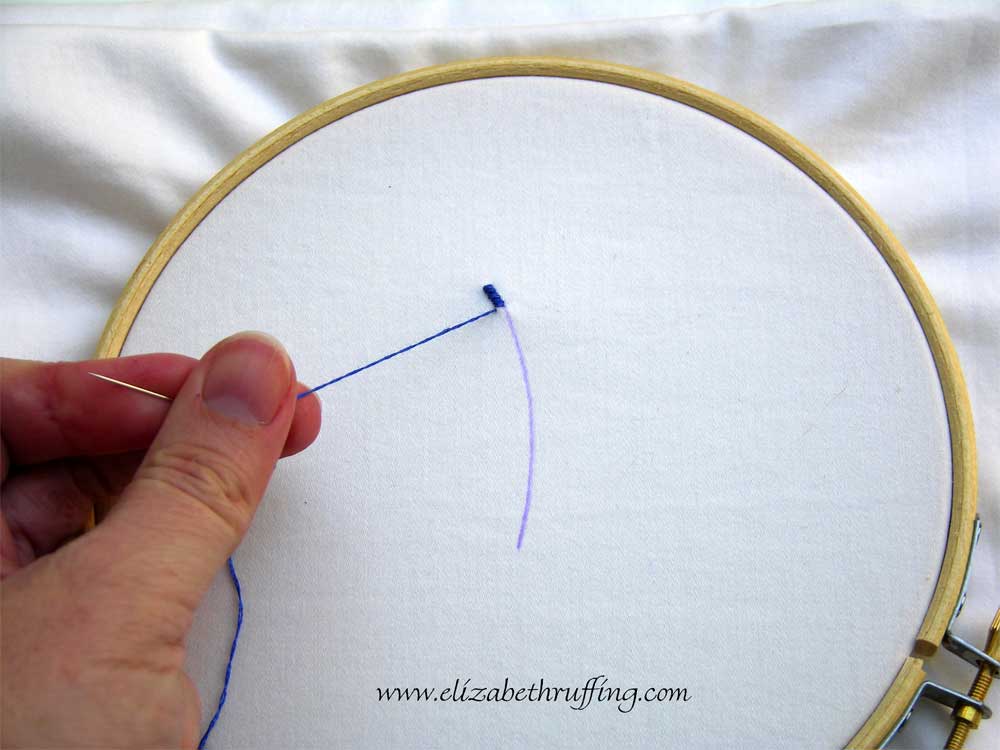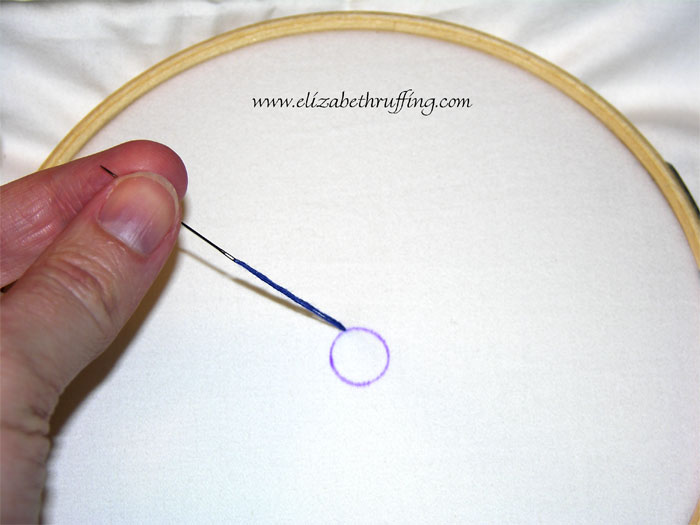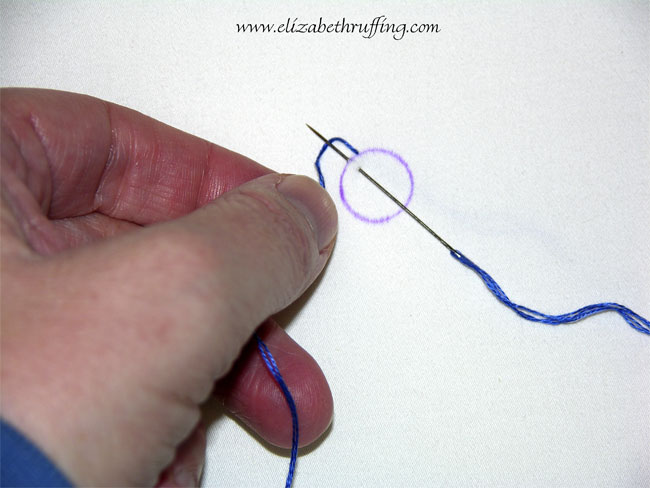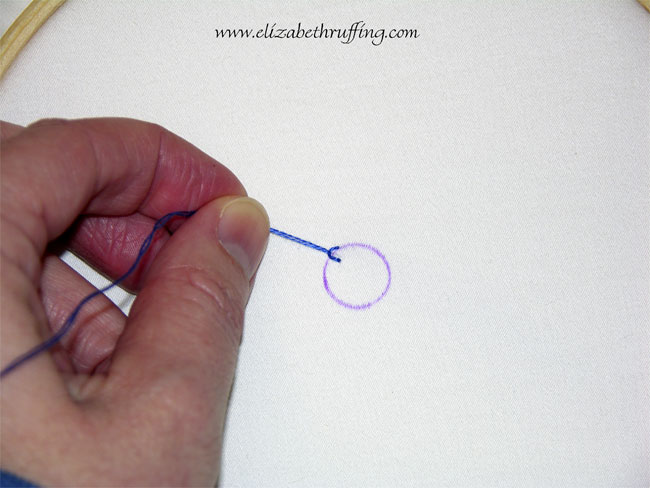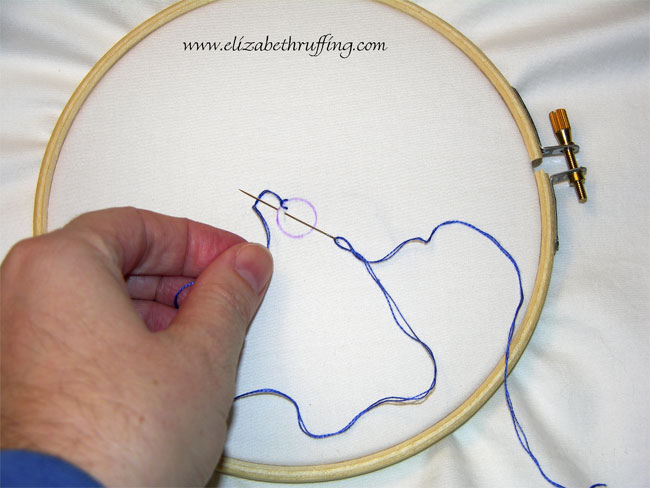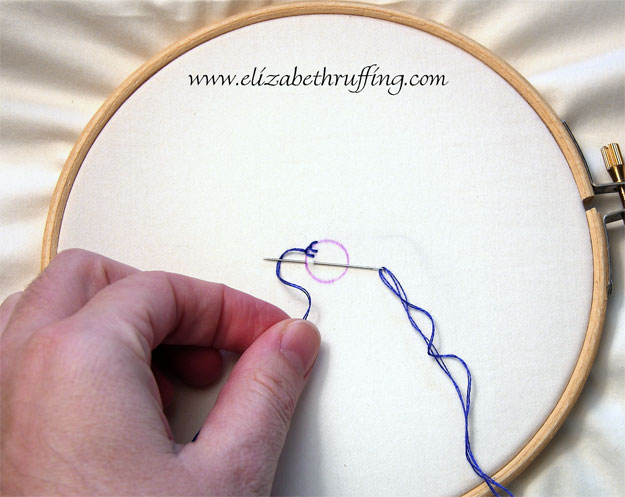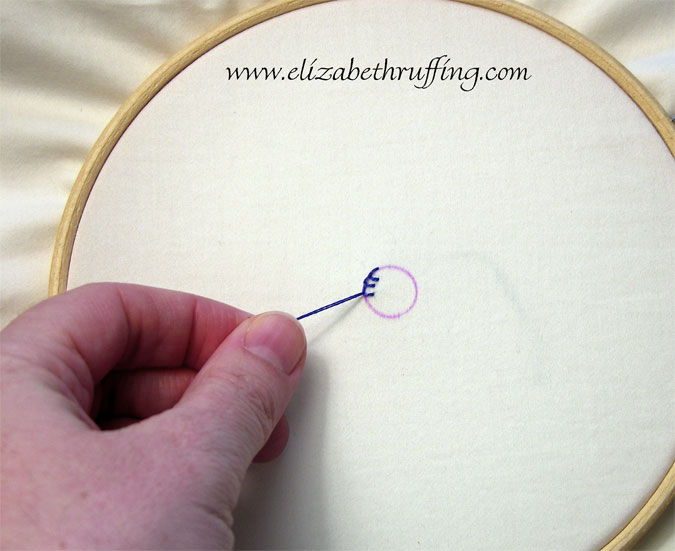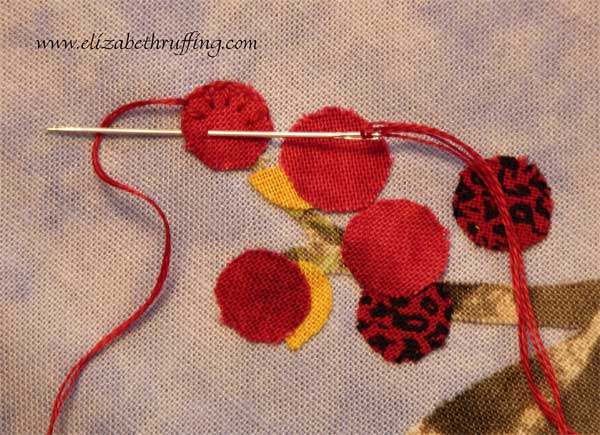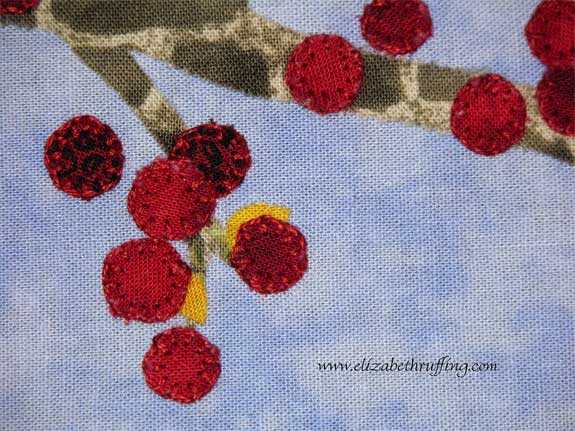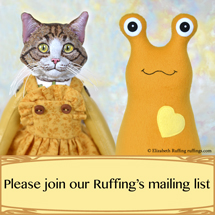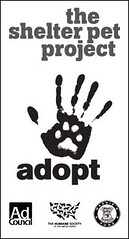 I haven’t yet finished my quilt block-of-the-month homework from this past year, or the year before, or maybe any year, but…I have just started two more classes. One is an appliqué class, and the first block is a bluebird. I was fiddling and couldn’t stop myself. I redesigned the whole block. Then I thought it might be a nice thing to share since I could show some raw edge appliqué in action, and then I could embellish my design with hand embroidery, which I am determined to learn. So…if you would like to stitch along with me, please download and print the PDF for my design. You will need to download Adobe Reader, if you don’t already have it. It is a nine inch square design, which won’t fit on 8 1/2 by 11 inch paper. So, you will use the center marks on the design for placement.
I haven’t yet finished my quilt block-of-the-month homework from this past year, or the year before, or maybe any year, but…I have just started two more classes. One is an appliqué class, and the first block is a bluebird. I was fiddling and couldn’t stop myself. I redesigned the whole block. Then I thought it might be a nice thing to share since I could show some raw edge appliqué in action, and then I could embellish my design with hand embroidery, which I am determined to learn. So…if you would like to stitch along with me, please download and print the PDF for my design. You will need to download Adobe Reader, if you don’t already have it. It is a nine inch square design, which won’t fit on 8 1/2 by 11 inch paper. So, you will use the center marks on the design for placement.
Please note this is my original drawing and it is copyrighted. In this instance, I am allowing copies to be made for personal use only. Selling my design or making items to sell from my design is not allowed, but you may make the design up to keep for yourself or to give to friends or whomever you like. Please credit me with the design if you publish your version of my design anywhere.
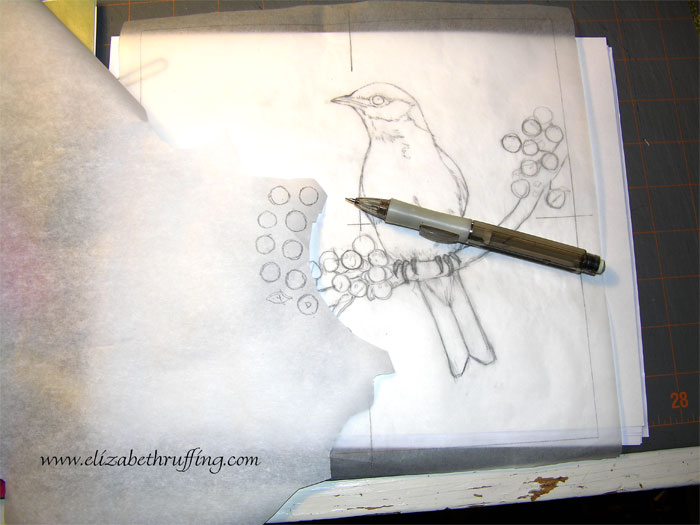 Okay…First of all, you will need some things:
Okay…First of all, you will need some things:
- Tracing paper
- Ruler
- Pencil (I like the mechanical kind)
- Paper-backed fusible web (I like Wonder-Under)
- 10 inch square or larger of background fabric (I used a pale lavender-blue cotton quilting fabric, 11 1/2 square)
- Assorted fabric scraps in navy, royal blue, rust, tan, cream, gray, and two reds (I used cotton quilting fabrics)
- Optional embroidery tracing paper, or graphite paper and a hard pencil (I used a 2H pencil)
- Optional disappearing ink pen, or permanent marker (I used a Pigma pen)
Cut a ten inch square of tracing paper and draw a nine inch square on it. Mark the center on all four sides and mark the middle of the square with a cross. Match the center marks up with the center marks on my design and trace the design onto the tracing paper. You may simplify the design all you like. You’ll be working from the tracing. Using the color picture at the top of this post as a guide, simplify the design into shapes by what color goes where.
Flip your tracing over to the reverse side. If you don’t do this, your design will be facing the opposite direction when you are done.
Lay your paper-backed fusible web over the tracing and draw the shapes for each color onto paper side of the fusible web. Give yourself about an extra eighth to a quarter of an inch of paper-backed fusible around each shape. (For anyone who might not already know this, you can click on the blog images to make them larger if you need to.)
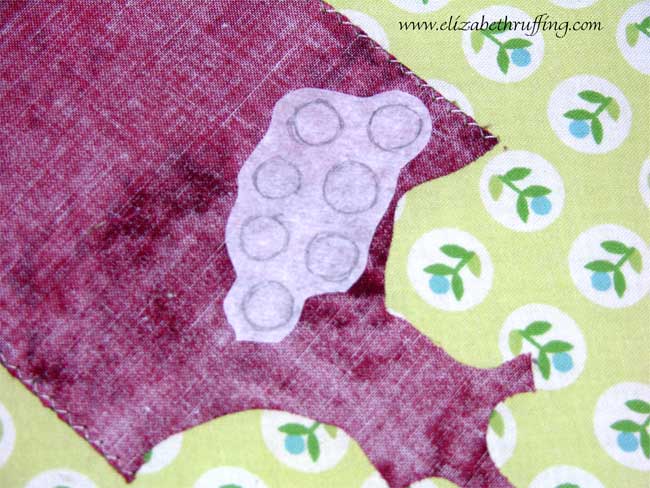 Fuse your paper-backed fusible shapes onto the wrong side of each of your fabric scraps, by color, following the directions on the package. Allow them to cool.
Fuse your paper-backed fusible shapes onto the wrong side of each of your fabric scraps, by color, following the directions on the package. Allow them to cool.
For the berries and the branch, you will simply cut along your drawn lines, except for either end of your branch where you will need to leave some extra fabric. You will trim your block down to size after it is stitched. Leaving a little extra on the sides of your block is a precaution against the small amount of fabric that gets taking up from stitching.
For the bluebird, you will leave an underlap where the edge of one color meets the next. This means you will leave an extra eighth to a quarter of an inch of fabric where one piece slips under another. It isn’t so important which piece goes under which. I started at the bottom of my bird, leaving a little extra at the top of each shape as I went up. So, the top of the tail, for instance, had a little extra fabric.
 Where there is no underlap, you will cut along your pencil lines.
Where there is no underlap, you will cut along your pencil lines.

Peel the paper off the back of your shapes, and use the tracing as an overlay to help you arrange the pieces on your background fabric. Mark the centers of the sides of your background fabric so you can line up your tracing. I used pins to do this. Start with the bird, working from top to bottom, laying the tail down first. As you go, lay your tracing over the fabric to see that everything is arranged the right way.
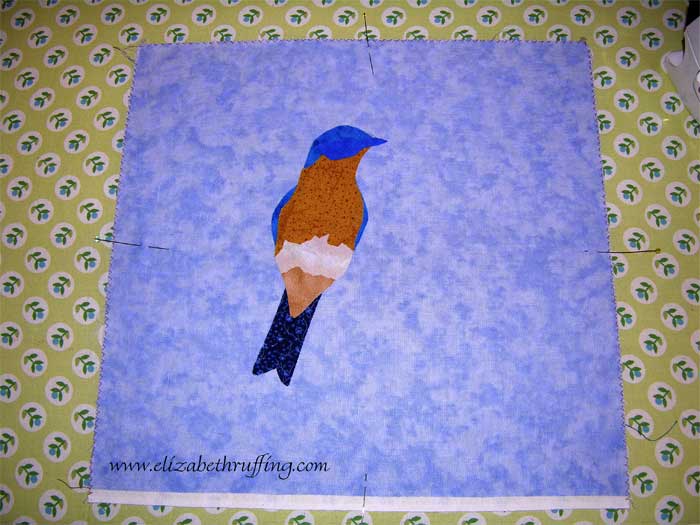
Once your bird is in place, fuse according to your package directions.
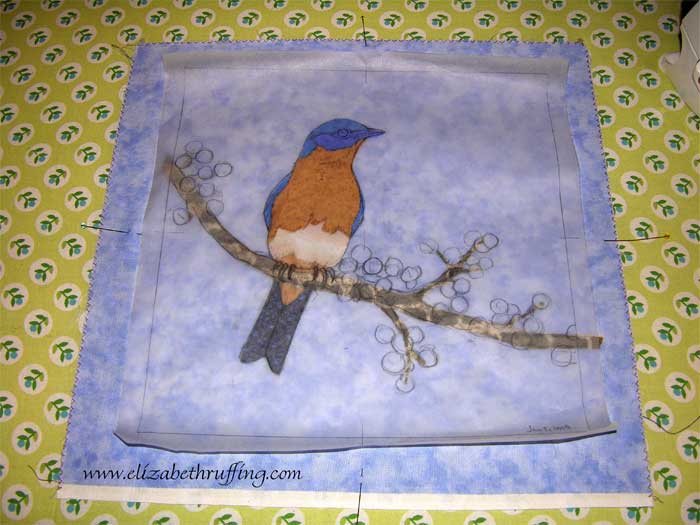
Next, lay the branch down and check its placement by putting your tracing over the fabric. Instead of following the center marks for placement now, you can just line up the drawing with your bird. It’s easier.

Fuse your branch in place.
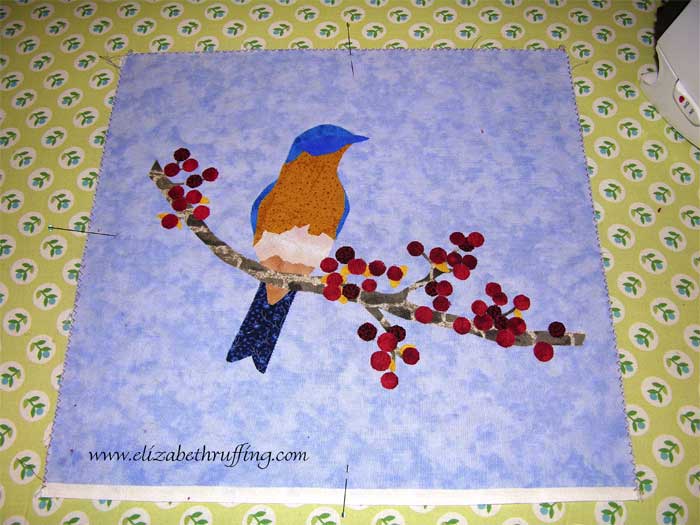
Lay down your red berries using the tracing as a guide as before and fuse them in place.
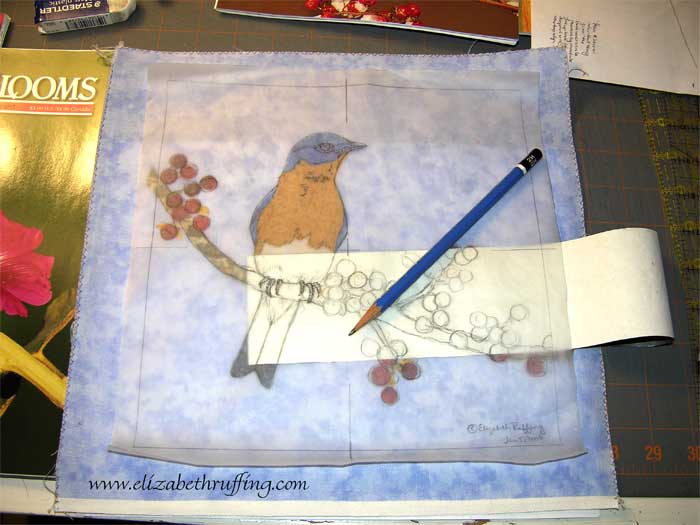
Using a hard pencil and a small piece of graphite paper, transfer the eyes and the claws of the bird onto your fabric. Instead of graphite paper, you can also draw on the back of your design and then flip your tracing to draw over the lines on the front. Or you can just “wing it” 🙂 That’s pretty much what I ended up doing.
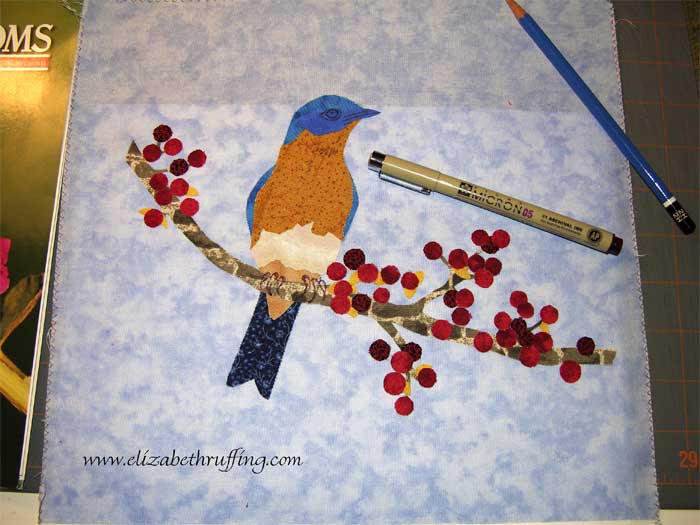
I went over my pencil lines with a permanent marker so I could see them better. You don’t have to do this. If you use a Pigma pen, be sure to let it dry for 24 hours before applying stream or getting it wet so it won’t run.

Now you are ready to embellish the design with machine stitching or hand embroidery. Whew. We’ll save that for another day.
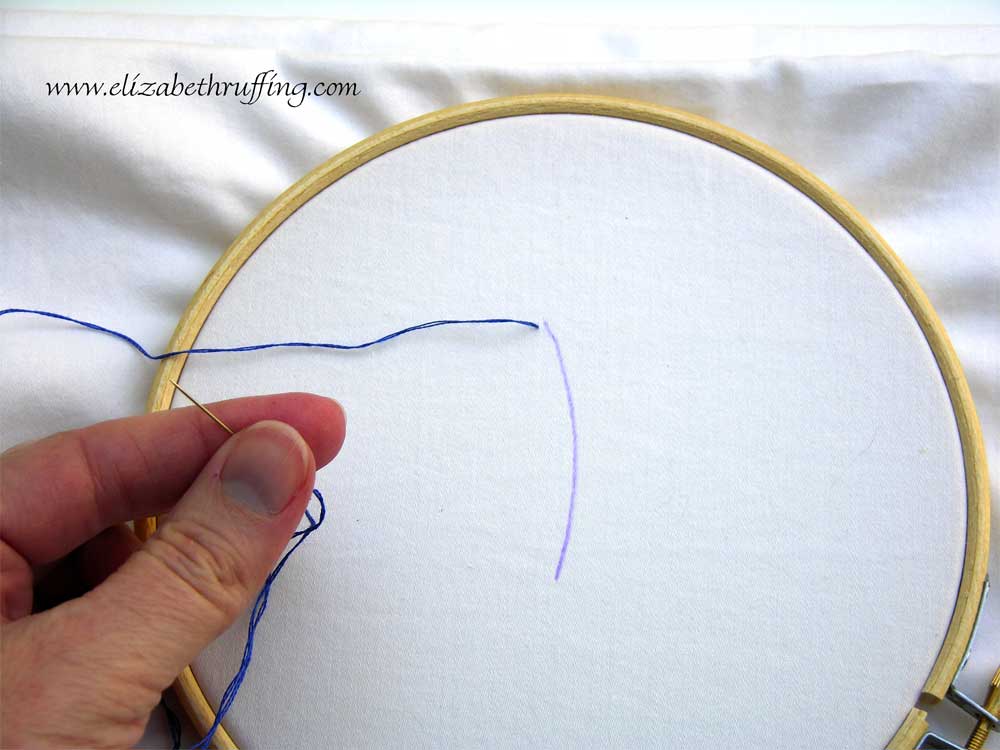 Back to the bluebird block…I finished embroidering the raw edges of the branch using the blanket stitch. I experimented with an alternate stitch, but liked the blanket stitch better. For the rest of my raw edges, for the most part, I used a satin stitch. The satin stitch was pretty easy and it looked very nice. Just a rundown on the basic steps first…Poke your threaded needle through your fabric from the wrong/back side to the right/front side of the fabric, just to the inside of your raw edge. I’m using a purple line in my photos to represent the actual edge of your appliqué. (You can click my photos to make them larger.)
Back to the bluebird block…I finished embroidering the raw edges of the branch using the blanket stitch. I experimented with an alternate stitch, but liked the blanket stitch better. For the rest of my raw edges, for the most part, I used a satin stitch. The satin stitch was pretty easy and it looked very nice. Just a rundown on the basic steps first…Poke your threaded needle through your fabric from the wrong/back side to the right/front side of the fabric, just to the inside of your raw edge. I’m using a purple line in my photos to represent the actual edge of your appliqué. (You can click my photos to make them larger.)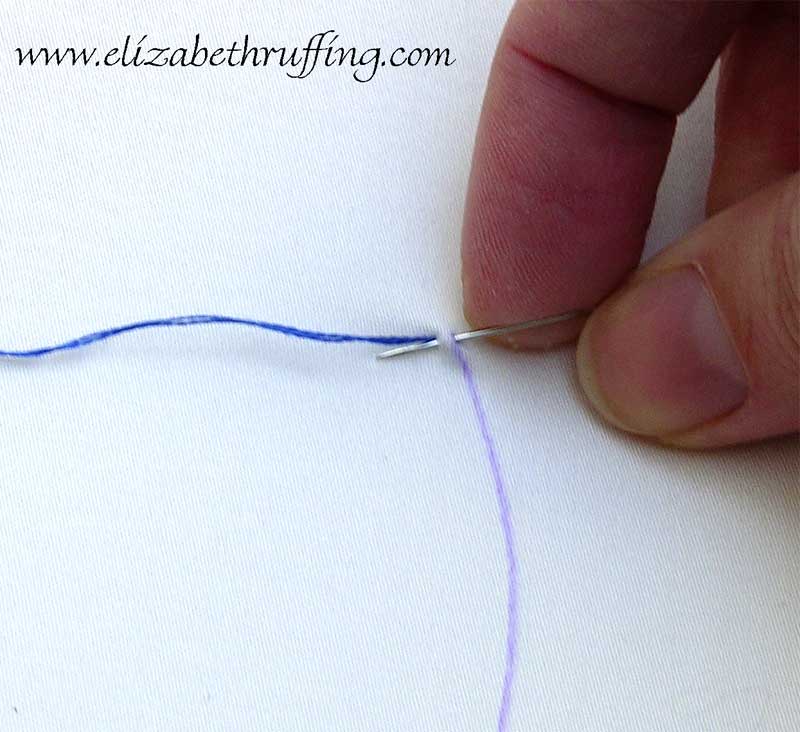 On the right/front side of your fabric, poke your needle through to the back of your fabric along your raw edge, and, in one movement, back out to the front of your fabric, just inside the raw edge, and just next to the point where your first stitch emerged.
On the right/front side of your fabric, poke your needle through to the back of your fabric along your raw edge, and, in one movement, back out to the front of your fabric, just inside the raw edge, and just next to the point where your first stitch emerged.
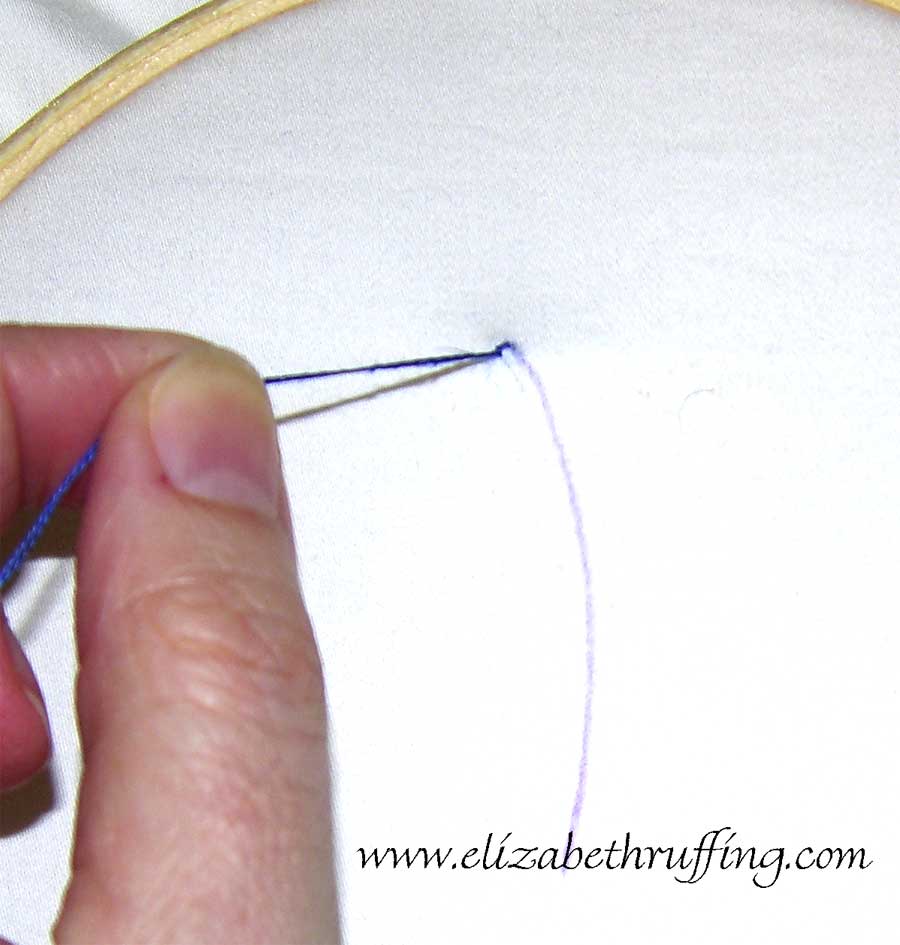 Pull your stitch gently taut without making it tight enough so that your fabric puckers. You will be repeating these basic steps over and over along your edge to finish your raw edge.
Pull your stitch gently taut without making it tight enough so that your fabric puckers. You will be repeating these basic steps over and over along your edge to finish your raw edge.
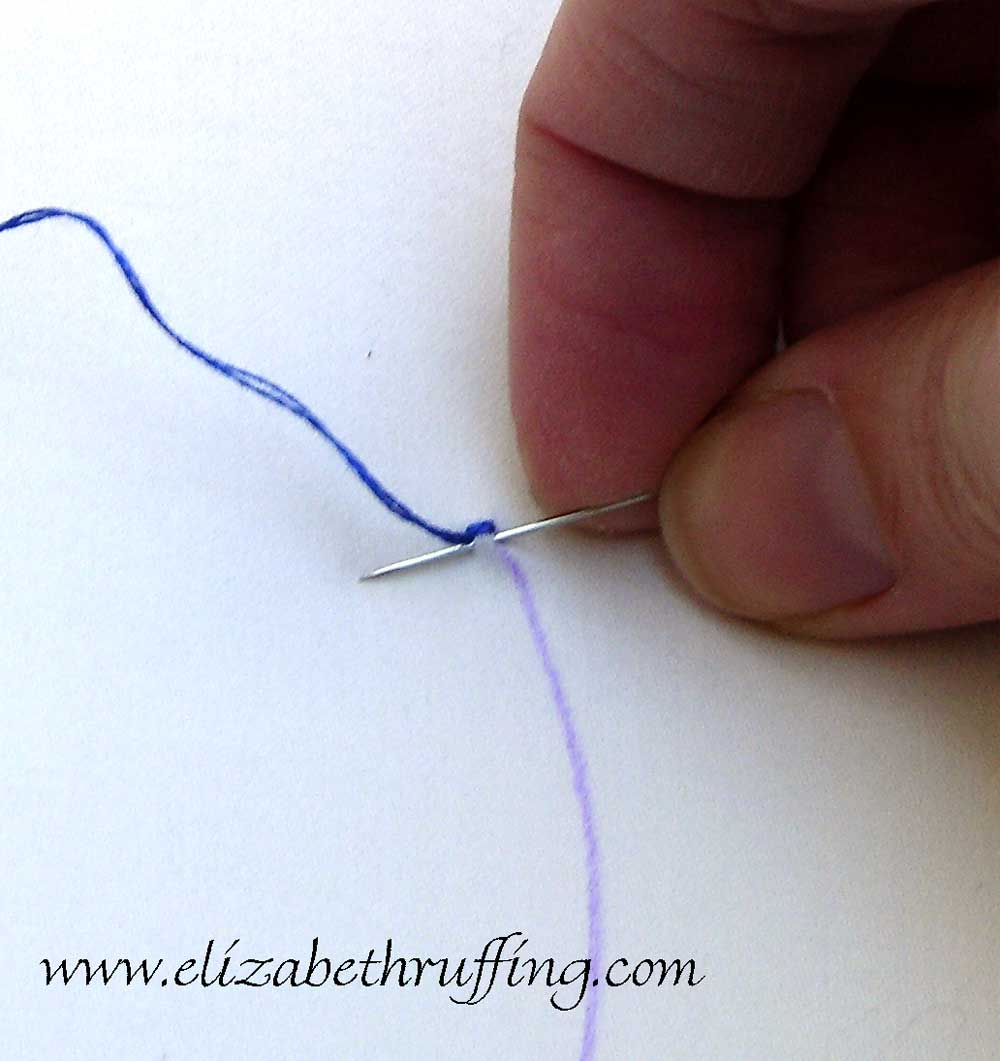 Take your next stitch just under your first stitch as you repeat the same steps.
Take your next stitch just under your first stitch as you repeat the same steps.
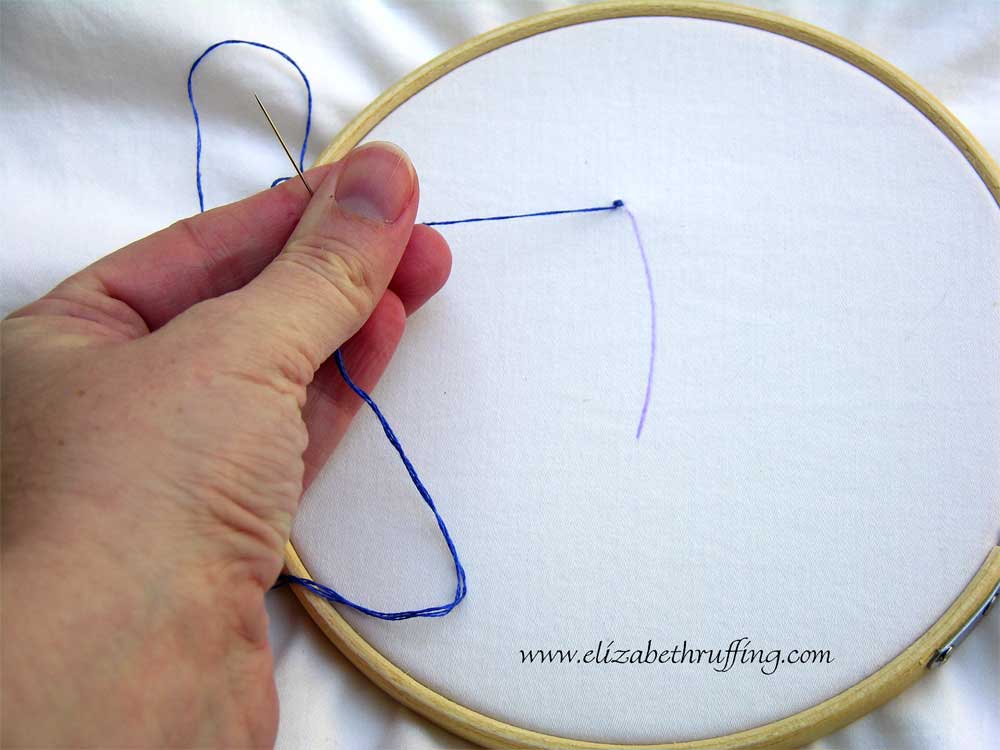 Keep an even tension on your stitches by pulling your floss gently.
Keep an even tension on your stitches by pulling your floss gently.
 Continue along your raw edge until you have reached the end of the shape you are working on. You will switch colors of embroidery floss depending on the color of your appliqué shapes. Again, I made a little knot in the back when I ended a color or ran out of floss on my needle. Since the block will be quilted, it shouldn’t matter too much.
Continue along your raw edge until you have reached the end of the shape you are working on. You will switch colors of embroidery floss depending on the color of your appliqué shapes. Again, I made a little knot in the back when I ended a color or ran out of floss on my needle. Since the block will be quilted, it shouldn’t matter too much.
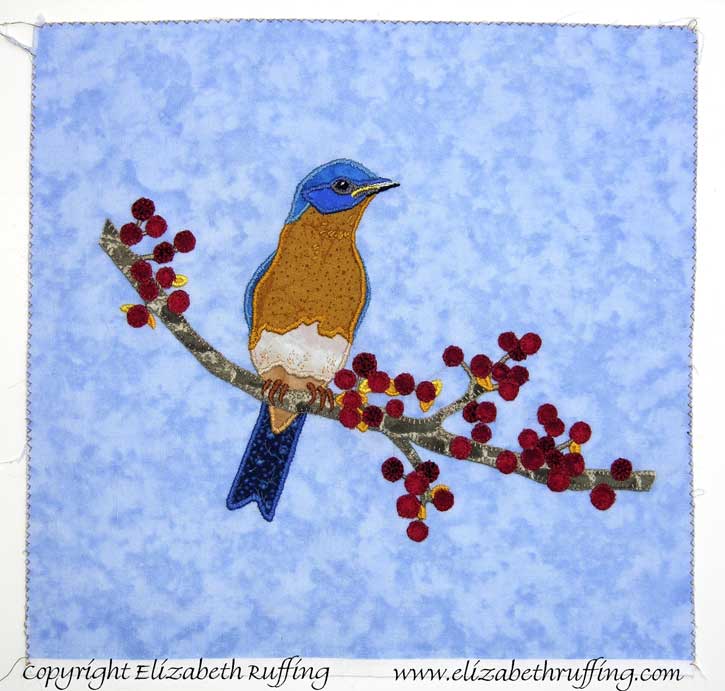 Following the edges of each colored shape, follow the basic satin stitch steps to finish each edge.
Following the edges of each colored shape, follow the basic satin stitch steps to finish each edge.
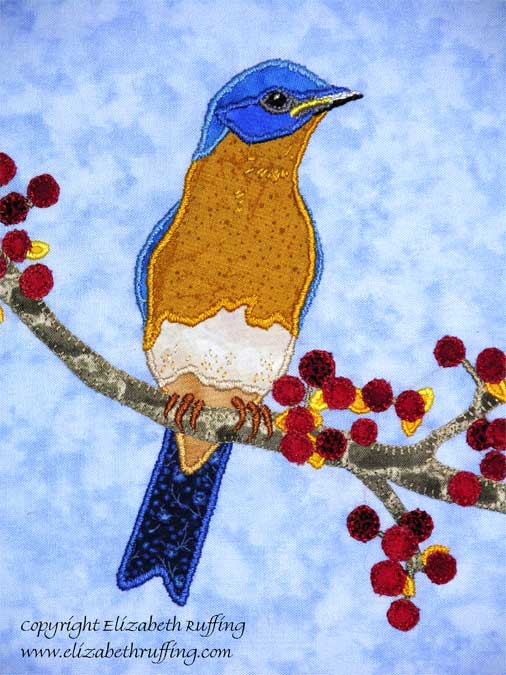 I took a few random stitches here and there just for effect, like on the bird’s belly and chest.
I took a few random stitches here and there just for effect, like on the bird’s belly and chest.
 I added a little white stitch in his eye for a highlight.
I added a little white stitch in his eye for a highlight.
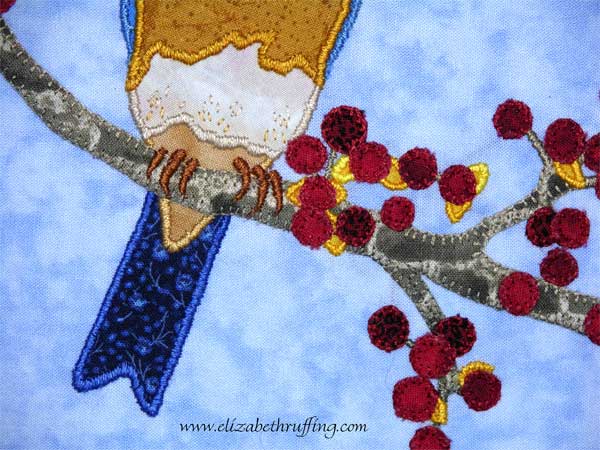 His claws are also done in a satin stitch. You can see the blanket stitch along the edges of the branch in this picture too. I tried using a lighter gray on the top of the branch, and a slightly darker gray along the lower edge of the branch. Where the branch got very narrow, I used a satin stitch right over my fabric because I felt it was too thin to hold up on its own.
His claws are also done in a satin stitch. You can see the blanket stitch along the edges of the branch in this picture too. I tried using a lighter gray on the top of the branch, and a slightly darker gray along the lower edge of the branch. Where the branch got very narrow, I used a satin stitch right over my fabric because I felt it was too thin to hold up on its own.
